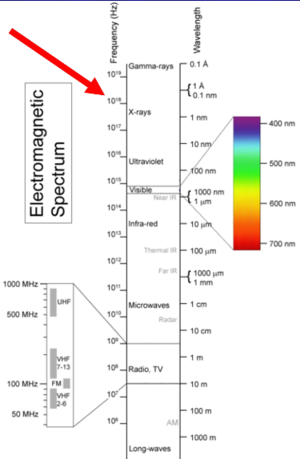Radiation Safety
X-rays are on the electromagnetic spectrum, they are massless particles that travel at the speed of light. They have a very short wavelength which gives it certain properties. You can't see it, it passes through things, and it ionizes all matter. In a biological system it can give rise to unwanted effects. The x-ray scatter is very similar to visible light scatter. Think of x-rays of short wavelength light that is ionizing.
Every x-ray machine uses the same fundamental method of producing x-rays. It is measured in volts (kVs), and milliamps. The focal spot is very small - generated from a point. The intensity drops off over the square of the distance (1 / r^2). This is called the inverse square law related to divergence. Getting closer to the source causing a rapid rise in intensity. X-rays interact with matter via ionisation, and the intensity reduces exponentially reduces due to attenuation. These two phenomenon - divergence and attenuation - can be used to improve safety.
X-ray beams can be measured. Exposure is the easiest thing to measure and is the charge per mass in air. Fluoroscopy systems have an air chamber which collects the amount of charge in that small volume of air, and the ionization of air is measured. The absorbed dose related to the energy per mass. It is measured in Joules per kilogram in Grays (Gy). Systems will measure this in milli-grays. An orthopaedic type procedure may be around 100mGy, while a radiotherapy dose may be around 50Gy. The equivalent dose is the biologically weighted absorbed dose and is measured in Sievert (Sv). This relates to the overall risk to the patient. For x-rays 1 Gy = 1 Sv (whole body exposure). Ethics risk calculations and occupational exposure calculations use Sieverts.
Natural background sources give around 2mSv. There is cosmic radiation, internal radiation, radon, mildly radioactive food. There is a slight variation in altitude with higher doses at higher altitudes. A patient dose is typically in 0.05-20mSv. Long cases may get up to 20mSv. Multi-phase CT scans can also get up to 20mSv. One of the challenges is that in over 100mSv as a single dose there is an increased risk of cancers. We live in this uncertain zone where we are working in a low level where we are not completely sure what the risk is.
Occupational exposure is similar to moving from a low altitude to a higher altitude area. Reducing population dose is focused on diagnostic procedures.
The total energy absorbed from x-rays) even at LD50 is very small. It is the microscopic energy deposition that is important (DNA the principal target). The repair of damage is very sophisticated (background radiation). Total repair leads to no effects. While mis-repaired or unrepaired damage leads to cell death (deterministic effects), or the cell can remain viable but have stochastic effects (cancer for somatic cells, and hereditary effects on germ cells). With the stochastic effects you can't always predict the effect. These effects have a threshold with effects not occurring below the threshold.
The organs and tissues of concerns are skin damage, cataracts, reduced IQ to the embryo, and impaired fertility with damage to gonads. We are starting to see these effects in dedicated rooms. There has been an increasing number of long complex x-rays, and increased capacity of modern x-ray tubes to produce x-rays. A couple of decades ago the tubes would overheat before excessive radiation production, but they are now oil cooled which has stopped this thermal limit. Some interventional fellows are reaching levels of over 0.15Gy per years which can cause cataracts. >0.15Gy can cause temporary sterility in testes. 4-6Gy can cause permanent sterility in testes, and 3-6Gy in ovaries. Transient erythema is the first effect, and the dose needs to get to 2Gy. Normal fluoroscopy is 50mGy per minute, so 40 minutes is needed to get transient erythema. Main erythema occurs at 6Gy, dermal atrophy at 11Gy, moist desquamation at 15Gy, and dermal necrosis at 18Gy. The repair process is quite quick, i.e. the effect is not accumulative over days. Fluoroscopy systems also will tell you the dose per area but this can lead to confusion.
Early transient erythema (dose >2000 mGy) appears a few hours after irradiation. It is an inflammatory response resulting in increased permeability of capillaries. This resolves over a few days even after high doses. It will always occur for doses much greater than 2000 mGy so it is an early indication that more significant skin effects are possible. Main Erythema (dose > 6000 mGy) appears around 10 days after irradiation. The rate of cell loss is independent of dose. Dermal necrosis (>18000 mGy) takes around 10 weeks to occur. Sicker patients will tend to receive higher doses with procedures. We work on the basis that effects are possible at low doses.
Populations exposed to radiation show an increase in cancer incidence. There is no unique radiation cancers. The risk of induction varies with organ. There is a delay before the increase is seen (a few years for leukaemia and bone tumours, and 20+ years for most solid cancers). There have been many epidemiology studies trying to evaluate the dose threshold. For example the Life Span Study (A-bomb survivers), was last reviewed in 1996. There were an estimated 420 excess cancer deaths among the 86,572 survivors within 2.5km of the epicentre.



